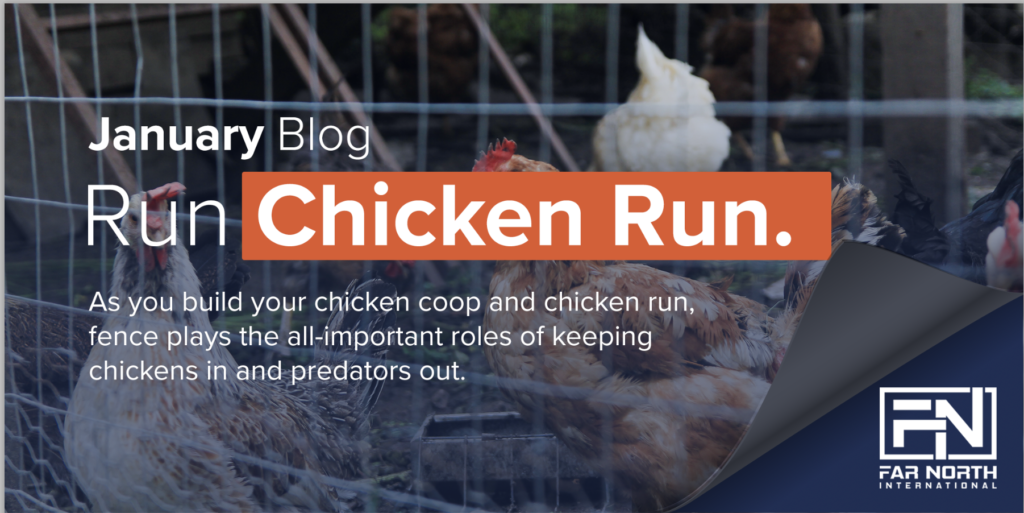With the rising cost of food in the U.S. it is no surprise that more and more Americans are looking to add egg farming to their daily routine. Which leads to two DIY projects that you might be looking to build in 2023: a chicken coop and a chicken run.
We at Far North don’t consider ourselves to be chicken experts, so we’ll concentrate on what we do know best and that is fence. As you build your chicken coop and chicken run, fence plays the all-important roles of keeping chickens in and predators out.
Chicken wire, or Hex Netting is light duty, economical fence that will address the basic needs for a chicken project. We offer rolls of 2’, 3’ and 4’ high fence in galvanized, which will last about 5 years. Consider using blue or green vinyl coated and double the life of your fence.
Hardware Cloth
If you are razing chickens from chicks, the hardware cloth’s tighter hole structure of ¼” or ½” squares is recommended to ensure that chicks will not escape the chicken run or coop. This smaller opening is also more effective at keeping out small rodents and weasels. For these reasons it is recommended for any coop openings. Galvanized and vinyl coated products are available in heights ranging from 2’ to 4’ tall.
the hardware cloth’s tighter hole structure of ¼” or ½” squares is recommended to ensure that chicks will not escape the chicken run or coop. This smaller opening is also more effective at keeping out small rodents and weasels. For these reasons it is recommended for any coop openings. Galvanized and vinyl coated products are available in heights ranging from 2’ to 4’ tall.
Welded Wire
A stronger alternative for general fencing of chicken runs, welded wire offers greater strength and more variety of options so you can choose the fence that fits your unique needs. Choose 1” x ½” opening to deal with small predators and help protect escaping chicks. Choose economical rabbit guard with smaller openings at the base that increase from bottom to top. We also offer vinyl coated fence which reduces the abrasiveness of galvanized metal and increases the life of your fence. From ½” to 4” spacing and everything in between your sure to find the option that fits your needs.
of chicken runs, welded wire offers greater strength and more variety of options so you can choose the fence that fits your unique needs. Choose 1” x ½” opening to deal with small predators and help protect escaping chicks. Choose economical rabbit guard with smaller openings at the base that increase from bottom to top. We also offer vinyl coated fence which reduces the abrasiveness of galvanized metal and increases the life of your fence. From ½” to 4” spacing and everything in between your sure to find the option that fits your needs.
Estimating a Chicken Run
Once you have selected your materials it is time to decide on your design. It is recommended to have 10 sq. ft. of space per chicken. Post spacing should be between 6 and 8 feet apart.
One possible design would be a 6’ x 12’ by 6’ high enclosure.
- Layout the 6’ x 12’ rectangle.

- Place a 4×4 post in each corner and one in the middle of the 12’ side. Posts should be 6’ tall from the ground.
- Place one additional post 3’ in the middle of one of the 6’ sides for a door.
- Place 2x4s between the posts to hold the shape of the box.
- Create a 4” deep trench around the enclosure for the lower fence to extend into the ground. This will prevent digging predators for getting in.
- Cut four 12’ lengths of fence. Attach two to each of the 12’ sides, one for the upper 3’ and one for the lower 3’ Fasten the fence to the posts with fence staples every 6”.
- Cut two 6’ lengths of fence. Attach them to the 6’ side, one for the upper 3’ and one for the lower 3’ Fasten the fence to the posts with fence staples every 6”.
- Cut two 3’ lengths of fence. Attach them to the 6’ side next to the door opening, one for the upper 3’ and one for the lower 3’ Fasten the fence to the posts with fence staples every 6”.
- Measure the door opening and build out a wood frame to match. Then cut out fence to match the openings.
- Cut four 6’ lengths of fence for the ceiling. Attach these to the top of the structure with fence staples every 6”. Wire can be used to connect the fence together if any fence seams meet where there is no wood.
- Fill in the trench using rocks for any gaps or openings.
Adding up all the lengths of fence in this project comes out to 96’ of 3’ tall fence, which would give you 4’ of slack in a 100’ roll. As an option two 50’ rolls could be used. One with a tighter structure for the lower half and one with a more open structure for the upper half.
Also take a look at – https://farnorthcorp.com/taking-care-of-chickens/ and https://farnorthcorp.com/much-to-do-with-eggs/


